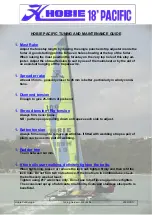
PAGE 20
This would not cause a serious beam problem as the
beams then simply move inboard to bear against the
hull again.
FLOAT/BEAM VENTS
The floats are vented through micro cowl vents fitted
to the float transoms. These are to prevent a buildup of
air pressure inside the floats on hot days that could be
enough to open up the hull to deck join.
Should the float be inverted as in a capsize, then the
airlock formed above these vents would prevent any
significant flooding.
The floats are vented through micro cowl vents fitted
to the float transoms. These are to prevent a buildup of
air pressure inside the floats on hot days that could be
enough to open up the hull to deck join.
Should the float be inverted as in a capsize, then the
RUST
Many grades of stainless steel will get an occasional
brown stain saltwater that can look like rust. The grade
used on most marine fittings is Type 304 or 303 and
both of these will show this. Type 316 which is a more
expensive grade but actually slightly weaker, does
not. All three grades can be used on your Pulse 600,
depending on the application. To avoid this staining,
always wash your boat down with fresh water after
every outing. The brown stains will not appear if the salt
is washed off.
CLEANING FLOATS
These can be extended for cleaning, if wished, while
boat is on the trailer. Float supports must be dropped
down and the boat then rocked one way. The ‘high
side’ float can then be extended. Let the boat lean the
other way and the remaining float can be extended.
You will need to support the floats in some way once
extended.
MAINTENANCE
In general, after every sail, the complete boat and trailer
should always be thoroughly washed down with fresh
water. This is very important to keep that new look and
to prevent rust taking hold on the trailer. Particularly,
wash out the brakes and suspension area of the trailer.
Regularly check the bilges of the center hull and floats
for any water. Sails should always be rolled up or folded
(the same way as you receive them) – dried first it wet.
If possible, keep your boat under cover as this will
ensure the finish keeps its gloss for the life of the boat.
Even the best gel coat finish will eventually begin to
fade. Polishing your Corsair Trimaran once a year will
maintain the gel coat shine and strengthen the gel coat
surface.
MAST
¡
Masthead sheaves should turn freely and clevis
or pivot pins should not be worn or show signs of
distortion.
¡
Sheaves should turn freely, and clevis or pivot pins
should not be worn or show signs of distortion.
¡
Forestay tab/nose should be checked for any
cracks or sign of distortion.
¡
All other stay attachments to mast should be
checked for distortion or corrosion.
HULL
¡
Check bow pad eyes and saddles for any
movement.
¡
Check all chain plates for any signs of movement.
¡
Check deck to hull joints where visible for any de-
lamination or cracking in joint.
¡
Check wing nets, particularly eyelets for wear.
Wing nets should be replaced every three or four
years. The taped edges are usually the first to fail and
sometimes just redoing these will extend the net life.
Replacement nets can be purchased from Corsair
Marine by contacting the factory or your local dealer.
¡
Check rudder case for any sign of stress cracks
particularly at lower end.
¡
Check dagger board around bottom edges of hull
for any stress cracks.
¡
Check leading and trialing edges of dagger board
for any de-lamination.
¡
Check control lines for wear and replace if
necessary.
¡
Check hull area around lower folding strut
brackets for any sign of damage/cracking.
STANDING RIGGING
¡
All stays should be checked for broken strands
or corrosion, particularly at end stages. If any
stays are badly kinked, replacement should be
considered. Stainless steel is prone to fatigue and
in a trailer boat it is not uncommon to get kinks in
the stays while rigging or de-rigging which further
fatigues the wire.
Check all turnbuckles for corrosion and that all locking
rings or pins are in place and work correctly.
https://www.boat-manuals.com/





































